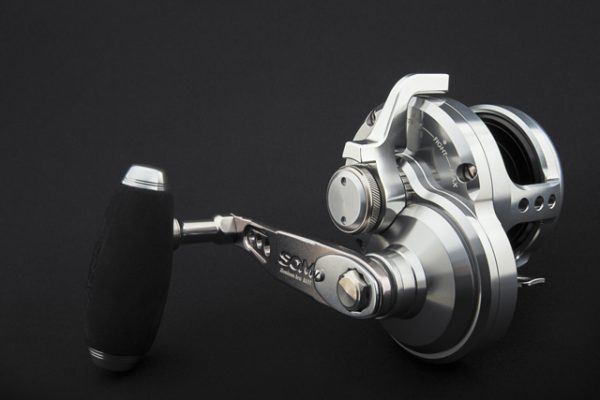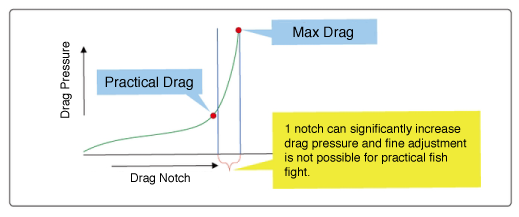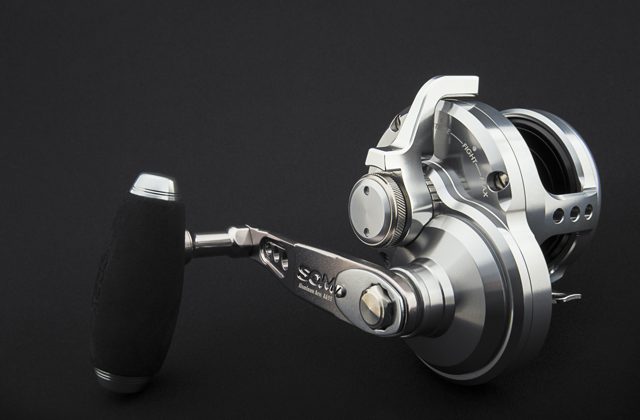Reel max drag too little?
Can you explain the relation between max drag and max fish weight?
I see that Ocea Jigger has only 7KG max drag in spite of the fact that it is very expensive.
There’s no equation between max drag and max catch size. Remember the fish weighs almost 0kg in the water.
If you are skilled in fish fight, you can bring home a 30kg fish with 5kg drag. Also we always load at least 600m line. We would need big margin to wear down the fish since a lot of times we can’t stop the fish.
When you fight with the light line like PE2.0, you don’t want to put on no more than 5.0kg drag.
Your line may hold more than 5kg for the straight tension, (Shimano EX8 PE2.0 is 40lb or 18kg class), but there are other considerations you should keep in mind.
- Your knots usually holds less weight. About 60% to 80%. See the article on line and knots
- Drag is measured when the line is loaded full on the spool. The actual drag weight increases when the line load is less. For example, set the drag at 5kg when the line is fully loaded. In the actual fight, much of your line is out of the spool. Your line load is less in diameter. Your spool is harder to be dragged to turn. It means the line will be holding the tension far more than 5kg.
- PE line is strong for straight tensions. But it’s very weak for frictions. You would only need less than 1kg to break the line by friction. When the drag is on, the line out of the spool will be holding the straight tension, but the line on the spool may be holding the friction. This is why the line needs to be spooled as tight as possible, and the line needs to be loaded as neatly as possible so that the line is not crossing the one underneath to create frictions. Fluffy load or crossed load can easily snap.

I suppose you are looking at OJ1500HG. I recommend to set the drag at 3kg with that reel. And that’s enough for the fish that this reel can handle. (Of course you may use your thumb or increase drag during the fish fight if it’s needed.)
Fine-adjustment of Drag
Shimano reels are so fine and specific with drag adjustments.
Whether the reel is a lever drag or a star drag, let’s suppose that the reel has 20 notches toward max drag. Theoretically speaking, one reel may have 7kg max, and it means one notch can increase 0.35kg drag average. Another reel may have 20kg max drag, and one notch increases 1kg average per notch. I’ve examined a reel like that before. Big drag, but it’s impossible to fine-adjust the drag. One notch felt like a jump. It should be OK with PE8.0, but not with PE2.0.
Don’t forget that if you are fighting a fish at 100m deep, the actual drag is greater than you set at full load. Sometimes you have to judge during such a fight whether or not you should tighten a drag by one notch…
So many anglers have cried in remorse for that one notch that ended up with the line break.
That’s how important that decision is and that’s how important the reel has a smooth curve of drag setting.
This is from Shimano website. In reality, drag pressure per notch increases smoothly and slowly toward Practical Drag point, and from that point on, jumps rapidly toward Max Drag.
I think Practical drag for OJ1500 is about 3kg+. There are only 4 or 5 more notches toward the full drag. After 3kg mark, you should pray when you gamble to tighten one notch with the fish on the line. This is such a finesse game with light line.
It is non-sense to think that expensive reel should have big drag capacity. Unless it’s “fine-adjustable” big drag capacity.
Shimano could easily engineer bigger drag capacity if they want to. After all, it’s just a disc brake. But as they have developed in the competitive Japan market, they have learned that fine-adjustable smooth drag is far more important than simply big max drag capacity for demanding Japanese anglers who like to fish with light lines.

Studio Ocean Mark makes one of the best SPJ reels in the market. The lever drag increases about 0.5kg drag per notch toward Fight position (Practical Drag). It increases rapidly toward Max Drag and the last notch increases 2kg drag. Studio Ocean Mark is very clear with that.
Tags In
Related Posts
12 Comments
Leave a Reply Cancel reply
Categories
- 1. SPJ (57)
- 1-1. Principles (9)
- 1-2. Techniques (11)
- 1-3. Setup (17)
- 1-4. FAQ (19)
- 1-5. Tackles (3)
- 1-6. Video Gallery (2)
- 2. Other Offshore Games (5)
- 3. Fishing Report (105)
- 3-1. Totos (25)
- 3-2. Readers (72)
- 4. Fish Cooking (19)
- 4-1. Iki-Jime (3)
- 4-2. The Art of Sashimi (5)
- 4-3. Recipe (7)
- 4-4. Seasoning (3)
- 5. Fishing Charter (6)
- Fish (12)







Hi,
Yesterday I made a big mistake with the drag setting on a Torium 16. I set it to the max (14lbs on my model). At 150 m depth a big fish hit the jig. Three times it carried the jig around leaving the line without any tension and then suddenly diving pulling quite a lot of line.
The Ocea EX8 1.5 line broke, probably near the PR knot.
My questions are:
1) Is PE line affected by grease and oil in the reels? The day before, while I was carrying the reel with no drag the line snagged inside the reel and I had to partially disassemble the reel to set it back on the spool.
2) If I use the correct drag setting, would Ocea EX8 1.5 be enough to carefully bring back to the boat fish we encounter here such as tuna, swordfish, small sharks, Mediterranean spearfish or a big greater amberjack
3) If 1.5 isn’t enough, will 2 do it or do I need even more?
4) When doing the PR knot is it possible to damage the line if pulling too much when doing the half hitches ?
Hope this helps someone else.
Thanks for advice
I’m sorry you lost the big fish. It’s a constant learning process, isn’t it? You always have to take chances too. Light line for contact rate or heavy line for catch rate.
Grease wouldn’t affect the line but it’s possible that snagginf has damaged the line, I think. Half hitch can damage the line if you do it too tight.
Have fun learning!
Hi Totos,
Your amazing site is highly addictive and I am learning a lot. I have a question about this toppic. In med me and my friends mostly targeting grouper and snapper (and their cousins)
If I let +15kg fish to face my 5kg drag they directly go under a stone and 50% they never leave. What do you recomend?
Hi Atila.
Thank you so much for supporting Japanese Angler’s Secrets.
Yes, this is inevitable with fishing with light line.
A 15kg fish does not weight 15kg in the water. Actually they weight 0kg in the water. What we are up against is their swimming power. But I know what you mean.
You have 2 options.
Thumb to stop, or free the spool.
Read more in this article.
http://anglers-secrets.com/v2020/fish-fight-part-2-fighting-strategies/
There is a lot more to it, but it’s just too hard to explain in words.
Good luck
Hi totos. Can you tell more about shimano ocea jigger reel? It is suitable for what rod or technique ? Long fall? Slow pitch? Or high pitch ?
Hi Syukri.
I would not select a reel in accordance to match the rod. The power (gear ratio) and the speed (max retrieve length per crank) are 2 major factors. The following is not based on specific data. Just my own personal perceptions. Just to give some ideas. Because it always depends greatly on the oceanic conditions.
=== Long fall ===
Long fall doesn’t require speed. But you tend to have a relatively heavy jig to the rod, therefore, in slow action tone.
OJ1500HG, probably up to 260g max, probably up to 130m. (you need to work a lot with max weight and water, though)
OJ2000HG, basically any jig, any depth.
=== slow pitch ===
Slow pitch requires a balance of power and speed in the reel. Both models have enough speed. You just need to work more to compensate the short power of the reel in some situations.
OJ1500HG, up to 230g, up to 100m, for your comfortable practice.
OJ2000HG, more than 300g, up to 200m.
=== high pitch ===
High power and high speed is required for high pitch jigging.
OJ1500HG, with up to 150g, up to 70m
OJ2000HG, with up to 220g, up to 120m.
(L50Hi, up to 260g, up to 150m)
This is based on an assumption that you are somehow vertical. If you are free-drifting, it’s hard to stay vertical. When you are little vertical, you would want more speed and power in your reel. When you are far from vertical, slow pitch doesn’t work no matter reel you have.
Hope it helps your decisions.
Tq totos. I like your articles so much. Because im new in jigging. One thing, how the overhead reel like SOM,OJ, etc control the line in a spool. I saw every overhead reel doesnt have any level winder. How to use overhead reel? Is it for professional angler? Sorry , this question not related to main subject.
Hi Syukri.
Thank you very much for your compliments.
Here’s the related article on the level winder.
http://anglers-secrets.com/v2020/why-do-we-use-the-reel-without-levelwider/
You just need to guide the line with your thumb or a finger when you pull up the jig. You can’t do the line management when you are fighting the fish, still, there are some time you can do line management when the fish is not fighting so much.
One thing for sure is that we are using a light PE line against possibly monsters. We want to be extra careful with the line. Absolutely no friction to damage the line. We have no margin to take risks as far as the line is concerned.
Hi totos, i have som L50 ratio 4.9:1 It is suitable reel jigging at 200-300 m depth
Hi John.
Yes, definitely.
It is not the reel which will be in question when you go that deep. It is your boat, the ocean conditions and whether or not it keeps you vertical.
hi totos, can OJ use for bottom fishing? which model/series is suitable for both jigging and bottom fishing.
tq
Slow pitch jigging is more demanding for the reel. I think you should choose the model for the condition for your SPJ game.
Basically I recommend OJ2000NR-HG if you are freedrifting.